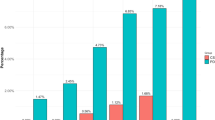Abstract
Impulse control disorders (ICDs) are a set of behaviours that take place in a subgroup of patients with Parkinson’s disease (PD). Although reduction or switch of dopamine agonists or decrease of levodopa are the common treatment, this does not always improve the compulsive behaviour. Zonisamide (ZNS) has proved effective for motor symptoms in PD and it may be also useful in the field of ICDs. The aim of our study is to evaluate the safety and efficacy of ZNS in PD patients with ICDs who did not improve following a reduction of either levodopa or dopamine agonists. Fifteen patients were initiated on 25 mg/day ZNS dosage, which was titrated to 200 mg/day, as tolerated. Severity of the behaviours was assessed by means of the Clinical Global Impression and the Barratt Impulsiveness Scale, while motor impairment was assessed by means of the Unified Parkinson's Disease Rating Scale (UPDRS). Demographic data, medication dose, treatment duration and adverse events were also collected and analyzed. There was a marked reduction in the severity of impulsive behaviours and global impulsiveness (mean change from baseline −5.8 to −4.8, respectively). UPDRS changed only marginally. ZNS was generally well tolerated. Our study suggests that ZNS may be effective for ICDs in PD. The lack of studies with other medications to treat these behaviours in PD and the potential beneficial effects of ZNS for motor complications make this drug important in the treatment of the disease.
Similar content being viewed by others
References
Evans AH, Strafella AP, Weintraub D et al (2009) Impulsive and compulsive behaviors in Parkinson’s disease. Mov Disord 24:1561–1570
Ceravolo R, Frosini D, Rossi C et al (2009) Prevalence of impulse control disorders in Parkinson’s disease. Neurol Sci 30(suppl):456
Bermejo PE (2008) Topiramate in managing impulse control disorders in Parkinson’s disease. Parkinsonism Relat Disord 14:448–449
Baulac M, Leppik IE (2007) Efficacy and safety of adjunctive zonisamide therapy for refractory partial seizures. Epilepsy Res 75:75–83
Bermejo PE, Dorado R (2009) Zonisamide for migraine prophylaxis in patients refractory to topiramate. Clin Neuropharmacol 32:103–106
Atli A, Dogra S (2005) Zonisamide in the treatment of painful diabetic neuropathy: a randomized, double-blind, placebo-controlled pilot study. Pain Med 6:225–234
Bermejo PE, Ruiz-Huete C, Dorado R et al (2008) Zonisamida en el temblor esencial refractario. Rev Neurol 46:139–142
Kinrys G, Vasconcelos e Sa D, Nery F (2007) Adjunctive zonisamide for treatment refractory anxiety. Int J Clin Pract 61:1050–1053
Murata M (2004) Novel therapeutic effects on the anticonvulsant, zonisamide on Parkinson’s disease. Curr Pharm Des 10:687–693
Murata M, Hasegawa K, Kanazawa I (2006) Zonisamide improves motor function in Parkinson disease. A double-blind study. Neurology 68:45–50
Bermejo PE, Anciones B (2009) A review of the use of zonisamide in Parkinson’s disease. Ther Adv Neurol Disord 2:313–317
Bermejo PE (2007) Zonisamide in patients with essential tremor and Parkinson’s disease. Mov Disord 22:2137–2138
Mamikonyan E, Siderowf AD, Duda JE et al (2008) Long-term follow-up of impulse control disorders in Parkinson’s disease. Mov Disord 23:75–80
Ardouin C, Voon V, Worbe Y et al (2006) Pathological gambling in Parkinson’s disease improves on chronic subthalamic nucleus stimulation. Mov Disord 21:1941–1946
Driver-Dunckley E, Samanta J, Stacy M (2003) Pathological gambling associated with dopamine agonist therapy in Parkinson’s disease. Neurology 61:422–423
Voon V, Hassan K, Zurowski M et al (2006) Prospective prevalence of pathological gambling and medication association in Parkinson disease. Neurology 66:1750–1752
Jiménez-Jiménez FJ, Sayed Y, García-Soldevilla MA (2002) Possible zoophilia associated with dopaminergic therapy in Parkinson disease. Ann Pharmacother 36:1178–1179
Gschwandtner U, Aston J, Renaud S et al (2001) Pathologic gambling in patients with Parkinson’s disease. Clin Neuropharmacol 24:170–172
Giovannoni G, O’Sullivan JD, Turner K et al (2000) Hedonistic homeostatic dysregulation in patients with Parkinson’s disease on dopamine replacement therapies. J Neurol Neurosurg Psychiatry 68:423–428
Grant JE, Potenza MN, Hollander E et al (2006) Multicenter investigation of the opioid antagonist nalmefene in the treatment of pathological gambling. Am J Psychiatry 163:303–312
Black KJ, Friedman JH (2006) Repetitive and impulsive behaviours in treated Parkinson disease. Neurology 67:1118–1119
Ceravolo R, Frosini D, Rossi C et al (2009) Impulse control disorders in Parkinson’s disease: definition, epidemiology, risk factors, neurobiology and management. Parkinsonism Relat Disord 15:111–115
Schauf CL (1987) Zonisamide enhances slow sodium inactivation in Myxicola. Brain Res 413:185–188
Biton V (2007) Clinical pharmacology and mechanism of action of zonisamide. Clin Neuropharmacol 30:230–240
Kito M, Maehara M, Watanabe K (1996) Mechanisms of T-type calcium channel blockade by zonisamide. Seizure 5:115–119
Chen JT, Garcia PA, Alldredge BK (2003) Zonisamide-induced restless legs syndrome. Neurology 60:147
Bermejo PE, Zabala JA, Saez R (2007) Restless legs syndrome induced by zonisamide. Mov Disord 22:1517–1518
Knapp CM, Sarid-Segal O, Richardson MA et al (2010) Open label trial of the tolerability and efficacy of zonisamide in the treatment of alcohol dependence. Am J Drug Alcohol Abuse 36:102–105
Conflict of interest statement
None.
Author information
Authors and Affiliations
Corresponding author
Rights and permissions
About this article
Cite this article
Bermejo, P.E., Ruiz-Huete, C. & Anciones, B. Zonisamide in managing impulse control disorders in Parkinson’s disease. J Neurol 257, 1682–1685 (2010). https://doi.org/10.1007/s00415-010-5603-7
Received:
Revised:
Accepted:
Published:
Issue Date:
DOI: https://doi.org/10.1007/s00415-010-5603-7




